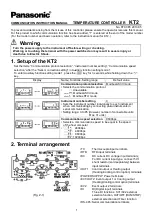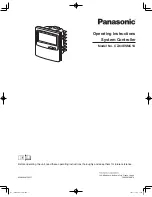
TG-10E/-13E/-17E Actuator
Manual 04045
8
Woodward
Oil grade selection is based on the operating temperature range of the actuator.
Also, use this information to aid in recognizing and correcting common problems
associated with oil used in products manufactured by Woodward.
Normally, the oil recommended for the turbine by the turbine manufacturer is
acceptable for use in the actuator.
Actuator oil is both a lubricating oil and a hydraulic oil. It must have a viscosity
index that allows it to perform over the operating temperature range, and it must
have the proper blending of additives that cause it to remain stable and
predictable over this range.
Actuator oil must be compatible with seal materials (nitrile, polyacrylic, and
fluorocarbon). Many automotive and gas engine oils, industrial lubricating oils,
and other oils of mineral or synthetic origin meet these requirements. Woodward
actuators are designed to give stable operation with most oils with a viscosity (at
operating temperature) between 50 and 3000 SUS (Saybolt Universal Seconds).
At normal operating temperature, the viscosity should be between 100 and 300
SUS. Poor actuator response or instability may be an indication that the oil
viscosity is outside this range.
Excessive component wear or seizure in an actuator indicates the possibility of:
1.
Insufficient lubrication caused by:
•
An oil that flows slowly when it is cold especially during start-up
•
No oil in the actuator
2.
Contaminated oil caused by:
•
Dirty oil containers
•
An actuator exposed to heating up and cooling down cycles, which
creates condensation of water in the oil
3.
Oil not suitable for the operating conditions caused by:
•
Changes in ambient temperature
•
An improper oil level which creates foamy, aerated oil
Operating an actuator continuously beyond the high limit temperature of the oil
will result in oil oxidation. This is identified by varnish or sludge deposits on the
actuator parts. To reduce oil oxidation, lower the actuator operating temperature
with a heat exchanger or other means, or change to an oil that is more oxidation-
resistant at the operating temperature.
WARNING—OIL VISCOSITY
A loss of stable actuator control and possible turbine overspeed may result
if the viscosity exceeds the 50 to 3000 SUS range. Loss of governor control
can cause damage to equipment and personal injury or loss of life.
Specific oil viscosity recommendations are given on the Oil Chart (Table 3-1).
Select a readily available good brand of oil, either mineral or synthetic, and
continue using that same brand. Do NOT mix different classes of oils. Oil that
meets the API (American Petroleum Institute) engine service classification in
either the “5” group or the “C” group, starting with “SA” or “CA” through “SF” and
“CD” is suitable for actuator service. Oils meeting performance requirements of
the following specifications are also suitable: US MIL-L-2104A, MIL-L-2104B,
MIL-L-2104C, MIL-L-46142, MIL-L-46152A, MIL-L-46152B, MIL-L-45199B.
Remove the breather/filler cap on the TG actuator. Fill the governor or actuator
with 1.8 quarts (1.7 L) of oil to a level visible on the oil sight gauge. Additional oil
is required if the governor uses an oil heat exchanger. Be sure that the oil level is
visible on the oil sight gauge before starting the turbine. After the turbine is
started and the TG actuator is at operating temperature, add oil if necessary.
Summary of Contents for TG-10E
Page 1: ...Installation and Operation Manual TG 10E 13E and 17E Actuator Manual 04045 Revision E...
Page 35: ...Manual 04045 TG 10E 13E 17E Actuator Woodward 31 Figure 7 1 TG Exploded View...
Page 41: ......
Page 42: ......
Page 43: ......













































